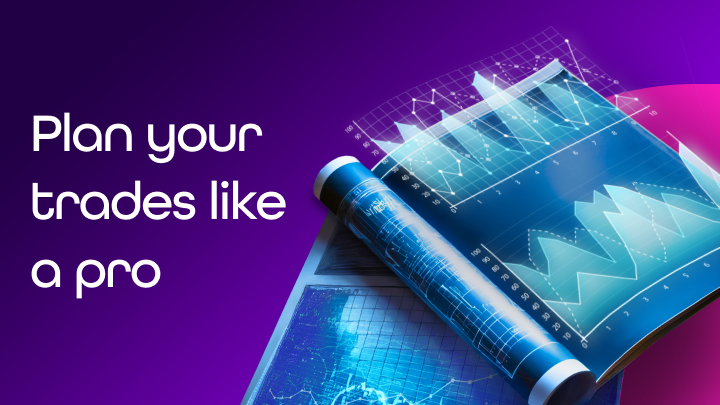Basic trading terms you need to know
Starting out in trading? Awesome — but before you dive into the charts, news, or strategies, there’s one thing you can’t skip: learning the language. The trading world has its own lingo, and knowing the basics helps you move faster, spot risks sooner, and stay in control.

Key terms and trading principles
Spread
The difference between the buy and sell price (ASK vs. BID).
The smaller the spread, the cheaper your trade entry. Crucial for scalping and intraday strategies.
Can you tell which spread is more trader-friendly?
EURCZK – 0.0084
EURUSD – 0.00005
(Hint: it’s EURUSD)
ASK / BID
ASK = the price you buy at.
BID = the price you sell at.
Spread = the difference between them = your entry cost. Easy, right?
Pip
Percentage in point. It’s the smallest price movement in a currency pair.
In most forex pairs, it’s the fourth decimal place.
E.g., if EUR/USD moves from 1.1050 to 1.1051, that’s 1 pip.
Long position
Betting the price will go up (BUY).
Short position
Betting the price will go down (SELL).
CFD (Contract for Difference)
A derivative that lets you speculate on price without owning the asset. In plain English: when you trade for example gold as a CFD, you don’t own gold – you’re just trading its price.
You can trade both up (long) and down (short) and use leverage to amplify your trades.
Most online trading with brokers happens via CFDs. Otherwise, clicking “buy” on a gold chart would mean you’re actually buying real gold. 😄
Swap
A fee (or reward!) for holding a position overnight. Based on the interest rate difference between currencies.
Swaps can be positive or negative, and can impact your result over time.
💡 Did you know?
The carry trade strategy earns passive income by holding positions with positive swaps long-term.
Stop-loss (SL)
A protective order that automatically closes a losing trade.
It’s a must for risk management.
No SL = No prop trading challenge passed.
Leverage
Lets you control larger positions with smaller capital. With 1:30 leverage, you can open a $30,000 position with just $1,000. ⚠️ But be careful—leverage magnifies losses too.
Margin
The amount your broker “locks” when you open a trade.
Having $100,000 in your account doesn’t mean it’s all available. A portion is always reserved as margin.
Pro tip: Watch out for margin calls – when your margin drops too low, the platform may start closing your trades automatically. (Margin Call is also one of the top 10 finance movies, in our opinion.)
💡 Pro tip
Watch out for margin calls – when your margin drops too low, the platform may start closing your trades automatically. (Margin Call is also one of the top 10 finance movies, in our opinion.)
Volatility
How much price moves. High volatility = more opportunities… and more risk. Markets jump up and down – that’s trader playground!
Liquidity
How easily an asset can be bought/sold at the quoted price. Higher liquidity = less slippage, tighter spreads, smoother execution. Basically: the more people trade it, the more liquid it is.
Risk/Reward Ratio (RRR)
The balance between potential loss and gain. E.g., RRR 1:3 = risk $100, aim for $300. Traders often aim for at least 1:2.
Slippage
When a trade opens/closes at a slightly different price than planned – usually during news events or low liquidity. Can be positive or negative depending on price movement.
Drawdown
Your most important metric at Fintokei.
The drop from your account’s peak to the lowest point during losing streaks. It shows “how much it hurt.”
At Fintokei, we track:
- Daily drawdown – Max % you can lose in a single day (from starting daily balance).
- Overall drawdown – Max % you can lose from your initial balance.
Exceed either and… game over.
| Program | Daily | Overall |
| ProTrader | -5% | -10% |
| StartTrader | -3% | -6% |
| SwiftTrader | ❌ | -10% |
Can you tame the drawdown? If so, we’ll get along just fine at Fintokei 😉
Basics of technical analysis
Technical analysis
Reading charts to understand market behavior. Markets tend to repeat themselves. Patterns form. Technical traders remember them. When they appear again, there’s a good chance the market will act the same way.
💡 Did you know?
Technical analysis is great for beginners—but combining it with fundamentals is even better!
Support
A level where buyers step in. Prices often bounce up from here. Breakthrough = market weakness.
Resistance
A level where sellers dominate. Prices often stall or fall. Breakthrough = potential strength.
💡 Did you know:
Traders often use the term “S/R levels” for support/resistance.
Moving averages (MA)
Indicators that smooth price action and help spot trends.
- EMA 20 = short-term trend
- SMA 200 = long-term trend
Crossovers = powerful signals.
💡 Did you know?
MAs are basic but solid tools to time market entries. Learn to use the MACD indicator and improve your market entry.
Reversal patterns
Candle chart shapes that signal trend changes. Ever heard of “head and shoulders” or “double top”? Now you have! Spotting reversal patterns can level up your trading game.
Divergence
When price goes up but an indicator (like RSI or MACD) doesn’t – or vice versa. It can signal a slowdown or reversal.
Candlestick patterns
One of the top reasons traders love candle charts. Individual candles form patterns with fun names like doji, hammer, or three black crows. Learning to trade technical analysis patterns will set you on the path to trading mastery.
Trendlines
Lines connecting highs/lows to show market direction. Breaking a trendline often means a shift is coming.
Trading styles & strategies
Scalping
Ultra-fast trades lasting seconds to minutes.
Small gains, high frequency. Needs low spreads, fast execution, and laser focus.
Swing trading
Hold trades for days or weeks. Goal: catch bigger moves between support/resistance. Swing trading strategies are perfect for newbies or busy people.
Intraday trading
All trades closed the same day. No swaps, no overnight stress—just clean daily action.
Breakout trading
Trading when price breaks key levels (support/resistance).
Strong moves can follow—but get confirmation from indicators or candle patterns.
Position trading
Long-term style. Hold trades for weeks, months, even years. Based on big-picture trends and fundamentals. This is where trading starts blending into investing.
Macro terms you should know
Fundamental analysis
The other big method. This is next-level stuff—tracking macro events, news, geopolitics, even weather.
Traders use the economic calendar to see what’s coming and how strong the impact might be.
💡 Tip
Beginners should avoid trading during major news, but pros often build entire strategies around it—because that’s when volatility (and opportunity) is 🔥.
FED
US central bank. Sets interest rates, controls inflation, drives market mood. Every word moves markets.
ECB
European Central Bank. Key for the euro, EU inflation, rates, and indices like DAX.
NFP (Non-Farm Payrolls)
Monthly US jobs report. Drops every first Friday. Huge impact on USD, gold, indices.
CPI / PPI
Inflation indexes.
CPI = Consumer Prices. PPI = Producer Prices. Higher inflation = higher rates.
Interest rates
Main tool of central banks. Higher rate = stronger currency. Rate decisions = high-impact news.
💡 Want to dig deeper?
Check out our blog series Zoom in: Trading Fundamentals – we break down the key terms, show how news moves markets, and help you trade smarter.
Wrap-up
Trading starts with understanding market language. Once you speak it, you’ve got an edge.
This article is your map—come back to it whenever you need a refresher.


